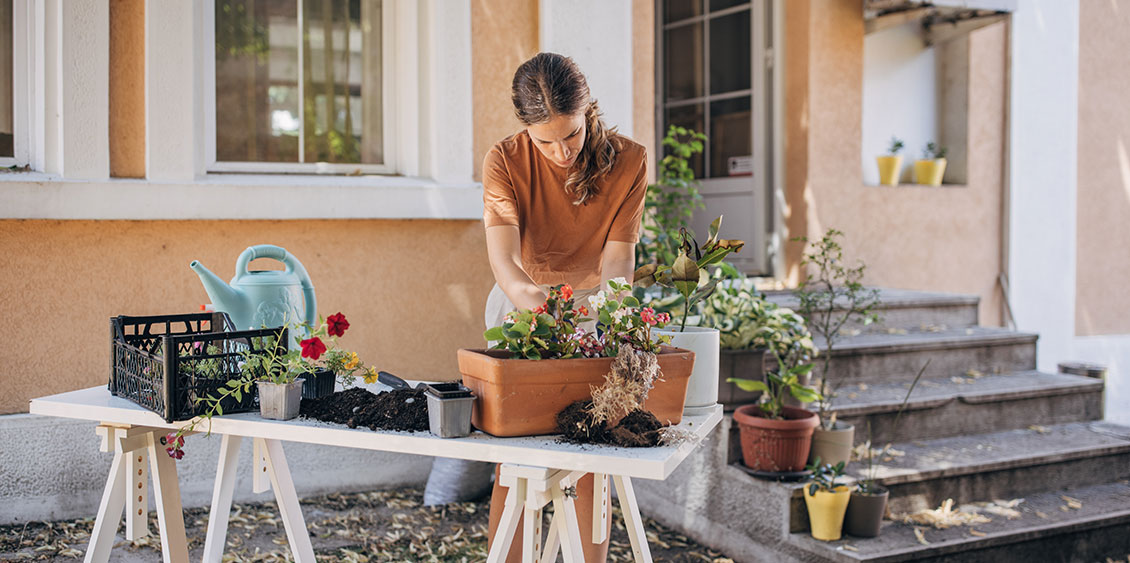Gardening is great for your body and mind. However, like many physical activities, it can sometimes leave you with a sore back, stiff arms, or aching knees. So how can you enjoy this calming pastime without getting injured? We have some simple tips from kinesiologists and your Brunet pharmacists to keep you safe and pain-free.

Regular physical activity: the key to pain-free gardening
It’s easy to forget that gardening is very physical. With so much bending, squatting, and lifting, it asks a lot of your body. One way to prevent injury is to stay active all year round. Go for walks, take the stairs, clean the house: every bit of movement helps prepare you for active tasks in the garden.
- Do you sit at a desk all day? Get into the habit of standing up regularly and walking around.
- Are you retired? A daily walk, some gentle yoga, or a bit of dancing can make a big difference.
- Do you have young children? Take some time on your lunch break or after work to play with them in the park.
The idea is to move regularly, even just a bit at a time. Increasing your overall daily movement will help get your body in shape for gardening.
Getting your body ready: an investment in your well-being
Gardening works many muscle groups, particularly in your back, arms, and legs. To enjoy your time in the dirt fully without pain or stiffness, it helps to prepare.
A few simple exercises two to three times a week can make all the difference.
- For arms and shoulders: Strengthening your biceps and triceps will make digging, shovelling, and lifting pots easier and less tiring.
Try lifting water bottles or use a resistance band for gentle curls while you watch TV.
- For the lower body: Strong thighs, legs, and glutes help protect your back when squatting or lifting bags of soil.
Leg squats or stair climbs are great for building and maintaining lower-body strength.
Tip: If you have limited mobility or live with chronic pain or arthritis, use long-handled tools, make raised garden beds, and take frequent breaks.
What are the health risks?
Like any physical activity, gardening can cause discomfort when you don’t take the right precautions.
The most common risk is joint or muscle pain, especially in the back, knees, and shoulders. These aches often occur when you push yourself too hard or stay in uncomfortable positions too often. Over time, these bad habits can lead to chronic tension, tendinitis, or more serious injuries.
Some people may also experience fatigue, which can be caused by heat, dehydration, or not taking enough breaks. For those with arthritis or other health conditions, there’s also a higher risk of aggravating existing pain.
Fatigue can lead to a lack of focus, which can make injuries more likely. If not treated promptly, even minor wounds can become infected. For instance, scrapes or cuts that happen while working in the soil can expose you to bacteria like tetanus. That’s why it’s important to wear gloves and properly disinfect any wounds.
Tips for safe gardening
Sunny weekends are here, and it’s the perfect time to tend to your garden. Before diving in, take a moment to prepare your body, whatever your age or experience level.
Starting off with the right habits can help you avoid a lot of discomfort. Here are a few tips to keep in mind:
- Start gently. Just a short warm-up is enough to wake up your muscles and joints. Light stretches, shoulder rolls, walking in place: the goal is to warm up your body before the work begins.
- Maintain a good posture. Keep your back straight, bend your knees when reaching down, and use tools that are the right size for you. These small adjustments make a big difference over a long afternoon in the garden.
- Listen to your body. If you feel stiffness or pain coming on, take a break. It’s better to spread out tasks over a few days than overdo it and put your health at risk.
- Be cautious during heatwaves. Dehydration can set in quickly, so keep water close by. You can also check out our tips and homemade recipes to help you stay hydrated while gardening in hot weather.
Gardening should be a simple pleasure, not something to worry about. By staying tuned in to your body and using good techniques, you can avoid next-day aches and pains.
What movements and postures should you adopt to garden safely?
Starting off with the right habits is the best way to prevent pain. Whether you’re new to gardening or have years of experience, here are a few key reflexes to build into your routine:
- Protect your knees. Use a cushion for kneeling or garden while seated to avoid putting too much strain on your joints.
- Keep your back straight. Bend your knees to pick up tools or lift bags of soil and avoid twisting while leaning forward.
- Push or pull instead of lifting. When possible, use a wheelbarrow or slide heavy items instead of picking them up.
- Use both hands. This helps distribute effort more evenly, especially for repetitive tasks like weeding or pruning.
How to garden without hurting your back
To protect your spine while gardening:
- Set up your garden at a comfortable height
- Use raised planters, about 70 cm to 80 cm off the ground.
- Build raised planting beds framed with borders.
- Use the right equipment
- Find tools with telescopic handles.
- Consider buying a rolling gardening seat.
- Wear a lumbar belt when exerting yourself.
- Be strategic
- Alternate between standing and sitting tasks every 30 minutes.
- Spread your work out over several days.
- Avoid heavy lifting early in the season.
How to garden without getting tired
When you love gardening, it’s easy to overdo it—especially on those first warm, sunny days when your energy is high. But remember that fatigue is one of the main causes of gardening-related pain and injury.
Here are a few simple ways to conserve energy:
- Break up your sessions. It’s better to garden for 30 to 60 minutes a day than to push through 3 or 4 hours in one go.
- Take regular breaks: A break in the shade, a glass of water, and some light stretching can prevent exhaustion.
- Pay attention to your body’s signals. If you start to feel tense or out of breath, it’s time to slow down.
- Vary the tasks. Switching between weeding, watering, planting, and repotting helps engage different muscle groups without overworking them.
Tip: Create a ritual. Enjoy a healthy snack, take a moment to rest, and go for a short walk before or after your time in the garden. Your body—and your mind!—will thank you.
Your kinesiologist: a partner in your health
When it comes to enjoying a safe and pain-free gardening season, nothing beats the advice of your kinesiologist. They have plenty of helpful tips and can show you ways to prepare your body for gardening that align with your abilities and comfort level.
Your kinesiologist can even create a personalized training program based on a full assessment of your fitness level. This program could include a detailed exercise plan to help you build strength safely. They can also provide motivational follow-ups (link in French only), which can help you stick with your routine long enough to see results.
When you’re tending your garden, you’re also tending to your well-being. By preparing your body, respecting your limits, and using proper techniques consistently, you’ll be able to enjoy every moment, without pain or frustration. Talk to your pharmacist for more tips on preventing injuries.
Last updated on July 10, 2025
Other articles that might interest you

